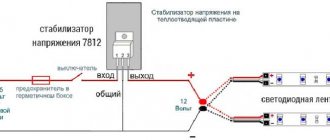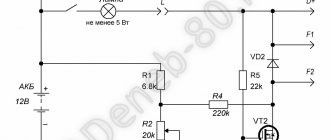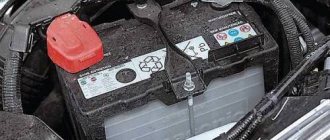Battery indicator - what color means what?
For convenience, many electrolyte batteries are equipped with a charge indicator; depending on the color indicator, it is easy to determine the state of the device. At its core, this indicator on the battery is a hydrometer.
The device of the battery discharge indicator is quite simple:
- There is a peephole on top that signals the status of the device;
- Next comes a column magnifying glass - it projects color into the peephole;
- At the bottom there is a leg with a green ball or two - green and red.
Depending on the charge of the device and the state of the electrolyte, the ball inside the case floats or sinks to the bottom. This provides a visual indication.
To evaluate the color indicator, first of all you need to lightly tap the eye, a screwdriver handle or something similar will do for this.
This process is not always necessary, but it often helps before assessing the color of the battery indicator, since tapping will expel any air bubbles that may interfere with viewing.
Manufacturers do not particularly experiment with color variations in the eye on the battery (usually a different designation is written on the instruction sticker); the following colors are common:
- green - a green ball has floated up. Normal indicator.
- red/black - the red ball floats up, when there is a black one in the eye - the ball is at the bottom. Requires charge.
- white/gray/transparent/yellow - the color is seen differently due to different color rendering and perception by the eye, but in reality it is the color of the transparent leg of the plastic sensor, in the case of yellow - the color of the electrolyte. There is not enough water.
Battery indicators by color
Owners of batteries with an indication often have questions regarding the color of the eye, why it lights up in one color or another and, vice versa, does not light up.
- What color should the battery indicator light up?
In this case, no recharging or any action is required.
- What does the red light on the battery mean? This also includes confusion about the black color of the battery indicator.
These colors indicate that the battery needs to be charged; if the device is left unattended, it will be completely discharged and may fail.
⦁ The indicator on the battery is white (gray or yellow).
This shade of the eye means that the electrolyte level has decreased. In the case of serviceable batteries, you need to add distilled water (sold in a pharmacy or auto shop) to the mark. If the battery is maintenance-free, we are talking about replacing it.
The battery eye has three colors - green, white and black, depending on the battery charge and the state of the electrolyte. Some devices use another color - red. Each color has its own meaning, thanks to which the car owner understands whether the battery is charged or discharged.
- Green indicator on the battery. If the eye is green, you can rest assured. This means the battery is charged and does not need to be recharged. You can use the car as usual.
- Red indicator on the battery. The red eye is an alarm signal informing the motorist that the battery is discharged and requires urgent recharging. In this case, you need to immediately remove it from the car and fully charge it.
- Black indicator on the battery. The black eye has the same meaning as the red one. The density of the electrolyte has decreased, the green ball has sank, and you see the blackness of the tube in the eye. Requires charging.
- White indicator on the battery. If the eye is white, it means there is not enough electrolyte in the battery. You can fix this yourself by disassembling the device and adding distilled water to it.
Some people are faced with the fact that even after a long period of charging, the color of the eye does not turn green. There are several reasons for this:
- the green ball is simply stuck in a narrow passage and does not fit into the right place - lightly shake the battery to move it;
- dirt from the plates, which crumble over time, prevents the indicator from showing the correct value;
- the battery has failed.
The peephole on the battery is a convenient way to check its charge level, but many car enthusiasts argue that this is a useless gimmick and you shouldn’t completely rely on its values. To accurately check the charge, it is better to measure the voltage using a load plug
Most modern car batteries are equipped with a small green indicator, but few drivers know what this mechanism is and what its main purpose is. Let's talk in more detail about what kind of sensor this is, for what purposes it is used and whether it is worth choosing batteries that are necessarily equipped with such a system.
Color designations
The battery eye has three colors - green, white and black, depending on the battery charge and the state of the electrolyte. Some devices use another color - red. Each color has its own meaning, thanks to which the car owner understands whether the battery is charged or discharged.
- Green indicator on the battery. If the eye is green, you can rest assured. This means the battery is charged and does not need to be recharged. You can use the car as usual.
- Red indicator on the battery. The red eye is an alarm signal informing the motorist that the battery is discharged and requires urgent recharging. In this case, you need to immediately remove it from the car and fully charge it.
Attention! Do not leave the battery completely discharged for a long time, as this may damage it.
- Black indicator on the battery. The black eye has the same meaning as the red one. The density of the electrolyte has decreased, the green ball has sank, and you see the blackness of the tube in the eye. Requires charging.
- White indicator on the battery. If the eye is white, it means there is not enough electrolyte in the battery. You can fix this yourself by disassembling the device and adding distilled water to it.
Read more: Adjusting valves in Gomel
Indicator modes
The following combination is very common: green, white, black. However, some manufacturers use the following combination: green, white, red. But essentially it's the same thing. Let's go through these readings.
Green mode – fully charged battery, can be used in normal normal mode. That is, charging is not needed.
White indicator - it tells us that the electrolyte level is low. This also happens in unattended ones; most likely, the battery was often recharged, and gaseous electrolyte was released through a special valve. You need to disassemble and add distilled water.
A black or red indicator - this tells us that our battery is low, and the indicator is critical and requires mandatory recharging! It is important! If the battery is left uncharged for a long time, it may fail.
As you can see, these colors give certain signals to the owner, look occasionally and then your battery will last a long time. I also want to note that this indicator does not have any light bulbs in its structure, the next point will change your understanding...
Why may the green light not light up after charging?
Some people are faced with the fact that even after a long period of charging, the color of the eye does not turn green. There are several reasons for this:
- the green ball is simply stuck in a narrow passage and does not fit into the right place - lightly shake the battery to move it;
- dirt from the plates, which crumble over time, prevents the indicator from showing the correct value;
- the battery has failed.
The peephole on the battery is a convenient way to check its charge level, but many car enthusiasts argue that this is a useless gimmick and you shouldn’t completely rely on its values. To accurately check the charge, it is better to measure the voltage using a load plug.
Information about the indicator on the battery To be honest, this indicator is created only to signal you about your battery, because as a rule, their design is not collapsible, and therefore you cannot climb inside and see what is with the electrolyte - just check its level or measure its density. Therefore, such a “light bulb” gives you a complete idea by which you can make this or that decision. However, the indicator may not always light green; as a rule, three modes are used here.
Indicator modes The following combination is very common: - green, white, black. However, some manufacturers use the following combination: green, white, red. But essentially it's the same thing. Let's go through these readings.
Green mode – fully charged battery, can be used in normal normal mode. That is, charging is not needed.
White indicator - it tells us that the electrolyte level is low. This also happens in unattended ones; most likely, the battery was often recharged, and gaseous electrolyte was released through a special valve. You need to disassemble and add distilled water.
A black or red indicator - this tells us that our battery is low, and the indicator is critical and requires mandatory recharging! It is important! If the battery is left uncharged for a long time, it may fail.
As you can see, these colors give certain signals to the owner, look occasionally and then your battery will last a long time. I also want to note that this indicator does not have any light bulbs in its structure, the next point will change your understanding...
Read also: New rules for the transportation of dangerous goods
About a light bulb - not a light bulb I wanted to write this information at the top, but this creates more intrigue. In the structure of this sensor, no light bulbs are used at all - neither ordinary incandescent (low-current) - as many people think, nor LED, nor anything else.
The structure here is different. In fact, this is an ordinary hydrometer, only built into the battery case. It automatically measures the density of the electrolyte, and at different values it pops up - one or another ball, which is projected through a magnifying glass tube and a magnifying glass into a special window. It should be noted that the balls float up as if along special grooves, which are made in the shape of a pyramid - this is important! REMEMBER!
If the battery is charged, a green ball floats up and you see it in the window. If it is discharged, then either red or nothing at all floats in, so you see blackness. But if there is no electrolyte, then the end of the pyramid seems to be exposed - you see its end in the window, many people confuse it with white.
The use of electrics in a battery would not be justified - even if the light bulb were low-voltage, it would still suck some of the energy from the battery (and in winter this is oh so unnecessary). YES, and if it burns out, the owner will start to get nervous.
Now a detailed video, maybe someone didn’t understand about the pyramid...
Why doesn't it light up even after being fully charged? A very common question, many still think that this is a light bulb and after charging it should light up! As we have already made clear, this is not at all true. And it is quite possible that when fully charged the green indicator will not come out! WHY?
The green ball can simply “stick” on these “small runners”. Just shake the battery and it will take its place. This happens very often. Dirt from the plates gets in, over time the plates begin to crumble, the electrolyte becomes cloudy, it has particles of lead, so it prevents the indicator from transmitting information normally. The battery really failed, this also cannot be ruled out, even with long-term charging it does not gain density. Is it possible to remove this indicator? On most batteries, yes, this window can be unscrewed, similar to a cork - but it will have to be twisted with force, it can even be broken; my friends unscrewed it using pliers with thin ends, and small “holes” were made in the window for engagement. In general, it’s a “collective farm”, but theoretically it’s possible to remove it! It is also worth remembering that if you unscrew it, then the airless space inside has been violated, and it is quite possible that a gaseous composition will come out - “explosive gas” or “HHO”. Then you will need to add distilled water. So always think, do you need to disassemble the battery?
Actually, I’m finishing the article, the information is clear and to the point, I think it was useful to you.
Varieties
Factory automotive indicators are classified according to the following indicators:
- Connection method. The device can be connected using the on-board network or the cigarette lighter connector.
- Signal display. The device can be digital or analog.
The operating principle of all indicators is quite similar. Devices for batteries are made in the form of information displays and hydrometers. Instead of standard models, you can use indicators made by other manufacturers. They are quite easy to place in the car.
Schematic design of the battery charge indicator
About a light bulb - not a light bulb
I wanted to write this information at the top, but it creates more intrigue. In the structure of this sensor, no light bulbs are used at all - neither ordinary incandescent (low-current) - as many people think, nor LED, nor anything else.
The structure here is different. In fact, this is an ordinary hydrometer, only built into the battery case. It automatically measures the density of the electrolyte, and at different values it pops up - one or another ball, which is projected through a magnifying glass tube and a magnifying glass into a special window. It should be noted that the balls float up as if along special grooves, which are made in the shape of a pyramid - this is important! REMEMBER!
If the battery is charged, a green ball floats up and you see it in the window. If it is discharged, then either red or nothing at all floats in, so you see blackness. But if there is no electrolyte, then the end of the pyramid seems to be exposed - you see its end in the window, many people confuse it with white.
The use of electrics in a battery would not be justified - even if the light bulb were low-voltage, it would still suck some of the energy from the battery (and in winter this is oh so unnecessary). YES, and if it burns out, the owner will start to get nervous.
Now a detailed video, maybe someone didn’t understand about the pyramid...
How the indicator works and how accurate it is
Many people are interested in how the battery peephole actually works and is designed? In fact, this is not a light bulb at all (neither ordinary, nor LED, etc.). Visually, the peephole resembles a light bulb, but it is an indicator of a slightly different operating principle. That is, what we take for light is not it.
It is a type of hydrometer device that is built into the desired location on the body. Its main task is to measure the density of the electrolyte. Based on this, it signals the driver with a specific color. The required ball floats out through a glass tube and is then shown to us through a specially provided window on the body.
Each colored ball has its own groove, along which they rise. When the battery is fully charged, a green ball appears in the window. If the charge is too low, a red indicator pops up. If there is no electrolyte in the banks, the end of the groove is exposed, so the driver sees a white circle.
This is a very non-standard and practical solution. After all, if ordinary light bulbs were installed in the housing, they would inevitably consume current and reduce the battery capacity. If it burns out, another problem would arise. It is necessary to somehow open the case and replace it if the car enthusiast wants to continue to see the condition of the battery.
However, this design may also have its flaws. For example, a ball is stuck in a groove, which confuses the driver. It turns out that you just need to shake the battery, and it will take its rightful place again. During constant use, the plates become sulfated, causing them to crumble. Lead particles fall into the working fluid and make it more cloudy. As a result, the indicator may convey false information.
Battery indicator color designations
This indicator color indicates that the battery is OK. The density of the electrolyte is higher than 12.5, so the lighter indicator ball, which is green, fits closely to the eye.
A very common question, many still think that this is a light bulb and after charging it should light up! As we have already made clear, this is not at all true. And it is quite possible that when fully charged the green indicator will not come out! WHY?
YES it's simple:
- The green ball can simply “stick” on these “small runners”. Just shake the battery and it will take its place. This happens very often.
- Dirt from the plates gets in, over time the plates begin to crumble, the electrolyte becomes cloudy, it has particles of lead, so it prevents the indicator from transmitting information normally.
- The battery really failed, this also cannot be ruled out, even with long-term charging it does not gain density.
People usually become confused after reproducing a full charging cycle or adding water. First of all, it is worth noting that the indicator should not immediately appear green - this is not a light bulb.
But most often the problem of the green ball not floating up is simple:
- you need to wait - the electrolyte has not had time to mix - this may take several days, while the battery itself will work;
- the ball is stuck - try shaking the battery a little;
- color distortion - over time, the battery plates crumble somewhat and make the electrolyte cloudy;
- The battery life has expired and it is time to replace it.
Battery indicators Beast and Tyumen
To monitor the condition of the battery while the charger is operating, we make a battery charge controller. The device circuit and components used are as accessible as possible, while at the same time providing complete control over the battery recharging process.
The operating principle of the controller is as follows: as long as the voltage on the battery is below the charging voltage, the green LED lights up. As soon as the voltage is equal, the transistor opens, lighting up the red LED. Changing the resistor in front of the base of the transistor changes the voltage level required to turn on the transistor.
This is a universal monitoring circuit that can be used for both high-power car batteries and miniature lithium batteries.
Why doesn't the green light on the battery light up?
People usually become confused after reproducing a full charging cycle or adding water. First of all, it is worth noting that the indicator should not immediately appear green - this is not a light bulb.
But most often the problem of the green ball not floating up is simple:
- you need to wait - the electrolyte has not had time to mix - this may take several days, while the battery itself will work;
- the ball is stuck - try shaking the battery a little;
- color distortion - over time, the battery plates crumble somewhat and make the electrolyte cloudy;
- The battery life has expired and it is time to replace it.
Battery indicators Beast and Tyumen
Information about the indicator on the battery To be honest, this indicator is created only to signal you about your battery, because as a rule, their design is not collapsible, and therefore you cannot climb inside and see what is with the electrolyte - just check its level or measure its density. Therefore, such a “light bulb” gives you a complete idea by which you can make this or that decision. However, the indicator may not always light green; as a rule, three modes are used here.
Indicator modes The following combination is very common: - green, white, black. However, some manufacturers use the following combination: green, white, red. But essentially it's the same thing. Let's go through these readings.
Green mode – fully charged battery, can be used in normal normal mode. That is, charging is not needed.
White indicator - it tells us that the electrolyte level is low. This also happens in unattended ones; most likely, the battery was often recharged, and gaseous electrolyte was released through a special valve. You need to disassemble and add distilled water.
A black or red indicator - this tells us that our battery is low, and the indicator is critical and requires mandatory recharging! It is important! If the battery is left uncharged for a long time, it may fail.
As you can see, these colors give certain signals to the owner, look occasionally and then your battery will last a long time. I also want to note that this indicator does not have any light bulbs in its structure, the next point will change your understanding...
Read more: Operating principle of a liquid pressure gauge
About a light bulb - not a light bulb I wanted to write this information at the top, but this creates more intrigue. In the structure of this sensor, no light bulbs are used at all - neither ordinary incandescent (low-current) - as many people think, nor LED, nor anything else.
The structure here is different. In fact, this is an ordinary hydrometer, only built into the battery case. It automatically measures the density of the electrolyte, and at different values it pops up - one or another ball, which is projected through a magnifying glass tube and a magnifying glass into a special window. It should be noted that the balls float up as if along special grooves, which are made in the shape of a pyramid - this is important! REMEMBER!
If the battery is charged, a green ball floats up and you see it in the window. If it is discharged, then either red or nothing at all floats in, so you see blackness. But if there is no electrolyte, then the end of the pyramid seems to be exposed - you see its end in the window, many people confuse it with white.
The use of electrics in a battery would not be justified - even if the light bulb were low-voltage, it would still suck some of the energy from the battery (and in winter this is oh so unnecessary). YES, and if it burns out, the owner will start to get nervous.
Now a detailed video, maybe someone didn’t understand about the pyramid...
Why doesn't it light up even after being fully charged? A very common question, many still think that this is a light bulb and after charging it should light up! As we have already made clear, this is not at all true. And it is quite possible that when fully charged the green indicator will not come out! WHY?
The green ball can simply “stick” on these “small runners”. Just shake the battery and it will take its place. This happens very often. Dirt from the plates gets in, over time the plates begin to crumble, the electrolyte becomes cloudy, it has particles of lead, so it prevents the indicator from transmitting information normally. The battery really failed, this also cannot be ruled out, even with long-term charging it does not gain density. Is it possible to remove this indicator? On most batteries, yes, this window can be unscrewed, similar to a cork - but it will have to be twisted with force, it can even be broken; my friends unscrewed it using pliers with thin ends, and small “holes” were made in the window for engagement. In general, it’s a “collective farm”, but theoretically it’s possible to remove it! It is also worth remembering that if you unscrew it, then the airless space inside has been violated, and it is quite possible that a gaseous composition will come out - “explosive gas” or “HHO”. Then you will need to add distilled water. So always think, do you need to disassemble the battery?
Actually, I’m finishing the article, the information is clear and to the point, I think it was useful to you.
How accurate is the indicator?
In general, it is not entirely correct to talk about the accuracy of such a warning system. It works more or less normally only on new batteries. In older models the following may occur:
- Ball sticking. To correct this defect, you need to lightly hit the peephole several times with a screwdriver.
- Ball stuck. Dirt from the electrolyte got into the tubes with the balls. This occurs due to the destruction and shedding of the internal plates of the battery. In this case, the electrolyte itself becomes cloudy.
- The battery stopped charging due to “old age”. The device has reached the end of its service life and can no longer operate normally or show the charge level.
All these cases can be found on any battery. Both domestic and foreign production.
Renault Kaptur chocolate › Logbook › Information about the indicator on the battery
Information about the indicator on the battery To be honest, this indicator is created only to signal you about your battery, because as a rule, their design is not collapsible, and therefore you cannot climb inside and see what is with the electrolyte - just check its level or measure its density.
Indicator modes The following combination is very common: - green, white, black. However, some manufacturers use the following combination: green, white, red. But essentially it's the same thing. Let's go through these readings.
Many motorists are faced with a problem when the battery is fully charged, but the red indicator does not change to green. There are three reasons why this could happen:
- The design uses special balls, and a situation often arises when they get stuck and cannot jump to the surface. In this case, you need to shake the battery and the indicator will show the desired color.
- The device has dirt from the plates, which prevents the correct transmission of information. This is due to the fact that the plates in any battery can crumble over time. Then the electrolyte becomes cloudy.
- It is possible that the device has malfunctioned and cannot charge properly. In this case, you need to contact specialists.
If necessary, you can remove the indicator yourself. In most cases, this can be done with simple pliers, but this “procedure” is unsafe. There is a possibility that the airless space inside the device will be disrupted. This will lead to the leakage of explosive gas. Therefore, it is recommended to think carefully about the need for such an action before starting it.
Operating principle
Hydrometers function as follows:
- As a result of charging the battery, the density of the electrolyte increases. The appearance of a green signal indicates that the battery charge level is greater than 65%. In this case, the voltage is more than 13 V.
- If the red indicator on the battery is on, the vehicle owner should take care of charging. The indicator indicates a voltage whose maximum value reaches 11 V.
- The blue signal occurs at a voltage that varies from 11 to 13 V.
If the electrolyte level drops sharply, the car owner will have to add purified water to the battery. If the battery is in poor condition, this procedure will be much more difficult. A built-in indicator will be the best option for drivers who prefer to know the preliminary battery charge level.
The removable indicator can be placed in the car interior, within the driver’s visibility range. Most often, the device is placed near the steering column. The advantages of such an installation include the suitable location of the LEDs, the absence of problems with control and connection to the ignition system.
Built-in car battery indicator
If the battery charging indicator does not light up, the car owner should pay attention to the condition of the light bulb and the battery itself. The first one may burn out, and the second one may suffer from reduced energy efficiency. To solve why the battery indicator is green and the battery is low, you need to visit a service center. It is not recommended to carry out repair work yourself in the absence of special knowledge and relevant experience.
On most modern batteries that are installed in vehicles, you can find a special light that glows in different colors, depending on the condition of the battery. If the battery indicator lights up red or another color, you can draw conclusions about the charge level of the device. It happens that inexperienced drivers are not aware of this feature.
Why do you need a peephole on a car battery?
Many car batteries are equipped with a special device that measures and shows the state of charge of the battery. The built-in charge indicator is located on the front (top) side of the device and looks like a peephole - by looking at it, the car owner quickly understands that everything is in order or that recharging is necessary.
The red color of the battery charge indicator means that the density of the battery has dropped below 12.5, the indicator ball has sunk in the electrolyte and the electrolyte allows the red color to pass through the eye, which is located at the bottom of the indicator.
Typically, these colors mean that the ball is at the very bottom of the indicator due to low electrolyte levels. And since the indicator itself is located outside the electrolyte (which is a light conductor for the indicator), you cannot see the red color of the bottom of the indicator.
Please note that some battery manufacturers have a different color indicator from the examples given in the article. For example, for Aktech and Zver batteries, a red indicator indicates a low electrolyte level, and a black indicator indicates a low battery discharge.
Built-in battery charge indicator
Built-in charge indicators can be found mainly on maintenance-free car batteries. This is a float indicator, which is also called a hydrometer. Let's see what it consists of and how it works. In the photo below you can see how this indicator looks on the battery case.
Built-in car battery indicator
Indicator removed from battery
The structure of the built-in battery indicator can be schematically represented as follows.
Schematic design of the battery charge indicator
The operating principle of most hydrometers is as follows. The indicator can show three different positions in the following situations:
- As the battery charges, the density of the electrolyte increases. In this case, a float in the shape of a green ball rises up the tube and becomes visible through the light guide into the indicator eye. Typically, the green ball floats up when the battery charge level is 65 percent or higher;
- If the ball sinks in the electrolyte, it means the density is below normal and the battery charge is insufficient. At this moment, a black indicator tube will be visible through the “eye” of the indicator. This will indicate the need to charge. Some models add a red ball that rises up the tube at a reduced density. Then the “eye” of the indicator will be red;
- And another option is to lower the electrolyte level. Then the surface of the electrolyte will be visible through the “eye” of the indicator. This will indicate the need to add distilled water. However, in the case of a maintenance-free battery, this will be problematic.
Battery needs charging
Requires topping up water
- The indicator is installed in only one of the six battery cells. This means that you will have data on density and degree of charge for only one jar. Since there is no communication between them, one can only guess about the situation in other banks. For example, in this cell the electrolyte level may be normal, but in some others it may be insufficient. After all, the evaporation of water from the electrolyte differs among the banks (in the extreme banks this process is more intense);
- The indicator is made of glass and plastic. Plastic parts may warp when heated or cooled. As a result, you will see distorted data;
- The density of the electrolyte depends on its temperature. The hydrometer does not take this into account in its readings. For example, on a cold electrolyte it may show normal density, although it is reduced.
It should be noted that to check the battery charge using the built-in indicator in the battery, you need to open the hood, wipe the “eye” and look. Most car enthusiasts look under the hood from time to time. Therefore, I would like to have some kind of device that shows the state of charge of the battery right in the cabin. And such devices have been developed by car manufacturers and third parties. Additionally, we recommend reading the article about self-maintenance of the battery. Return to content
What are the indicators?
There are different types of charge indicator. The most innovative models are on-board, built into modern cars, but this is still rare. The following types exist:
- crystal displays on instrument panels;
- indicators – hygrometers;
- a self-made version of the indicator.
At car dealerships, car enthusiasts purchase charge indicators of different models that differ in design and basic functions. Manufacturers offer the following types of models:
- by connection method: to the on-board network or to the cigarette lighter socket;
- by signal reproduction method: digital or analog.
These devices perform the main functions of determining the battery charge level and displaying indicators on displays or displays for viewing.
What are the car battery charge indicators?
Technology does not stand still and automotive manufacturers are trying their best to make car travel and maintenance as comfortable as possible. Therefore, on modern cars, in the on-board computer, among other functions, you can find data on the battery voltage. But not all cars have such capabilities. Older cars may have an analog voltmeter, which makes it quite difficult to understand the condition of the battery. For beginners in the automotive business, we advise you to familiarize yourself with the material on the charge rate of a car battery.
Such charge indicators are also produced by third-party manufacturers. They are quite easy to place somewhere in the cabin and connect to the on-board network. In addition, on the Internet there are simple schemes for making charge indicators with your own hands.
Let's take a closer look at all these types of battery indicators. Return to content
Display system design
An aerometer is a small tube at the end of which there is a float in the form of a colored ball. If the battery is well charged, the electrolyte density is high, and the ball rises to the top. This is what the car owner sees through a magnifying glass.
If the charge is insufficient, the density of the electrolyte drops and the green ball sinks. Instead, only the black tube of the device is visible and the eye appears black. In addition to the green one, some batteries also have a red ball. It is this that floats to the top when the density decreases, replacing green.
In addition to insufficient charge, the battery may have a lack of electrolyte. In this case, the surface of the liquid is visible in the eye, and the indicator becomes white.
Many people mistakenly believe that such a device is made in the form of an LED light bulb. However, the design of this device looks different. In most cases, a special hydrometer is used, which is built directly into the battery case. This device allows you to accurately determine the density of the electrolyte in the device.
If the battery is fully charged, there is a green ball at the top of the tube, which can be seen in the window and mistaken for a light bulb. If the device is low, a red ball pops up. In the case of black color, no ball floats up, and black color is simply visible in the window.
Automotive equipment manufacturers often use modern technologies. They provide an increased level of comfort when servicing the vehicle. New models are equipped with a battery monitoring system. In old VAZ 2109 and VAZ 2107 cars you can see analog voltmeters.
The demand for such a device as a charge indicator increases greatly in winter. Due to the negative impact of low temperature conditions, the battery discharges quite quickly. A significant cause for concern is the increasing frequency of situations that are accompanied by problems starting the car.
By assessing the state of the indicator, the driver will be able to determine the cause of the “disease.” The battery consists of 6 batteries. The voltage of each of them varies from 2.1 to 2.16 V. A standard device should produce no more than 13.5 V. When the battery is critically discharged, the freezing temperature increases and the density of the electrolyte decreases.
Significant wear of the battery is indicated by a noticeable decrease in the period during which it is able to hold a charge. In summer this is unlikely to pose a serious problem. In winter, an uncharged battery will not be able to ensure full operation of the dimensions. According to experts, a critical indicator is a charge of 30%. When it decreases, the electrical appliances with which the car is equipped stop working.
The simplest and cheapest option is a self-made IN. Its purpose is to control how the voltage in the on-board network works within the range of 6-14V.
The following parts will be needed for the diagram:
- printed circuit board;
- resistors: 2 with a resistance of 1 kOhm, 1 with a resistance of 2 kOhm and 3 with a resistance of 220 Ohm;
- transistors: VS547 - 1 and VS557 - 1;
- Zener diodes: one for 9.1 V, one for 10 V;
- LED bulbs (RGB): red, blue, green.
For LEDs, using a tester, you need to determine and check the pins so that they match the color. The device is assembled according to the diagram.
The components are tried on the board and cut to the appropriate sizes. It is advisable to arrange the components so that they take up less space.
Based on the manufactured device, it is impossible to determine specific battery voltage values; you can only navigate within what limits it is located:
- red lights up if the voltage is from 6 to 11 V;
- blue corresponds to voltage from 11 to 13 V;
- green means fully charged, meaning the voltage is greater than 13V.
The battery voltage indicator can be installed anywhere in the cabin. It is most convenient to place it at the bottom of the steering column: the LEDs will be clearly visible and will not interfere with control. In addition, the device can be easily connected to the ignition switch. After installation, the driver will be able to always know how charged his car’s battery is and charge his battery if necessary.
Price issue
If you buy a ready-made battery charging indicator, then the options presented below are possible.
Just recently a new Forse battery appeared under the hood. And here is the first adventure. The eye on the battery today noticed a black one. Just black. There is no color. The starter turns normally. There were no discharges.
I brought the charger. It took about 30 minutes to charge, and the charger said it was charged. But the peephole is still black.
I researched the structure of these eyes on the Internet. A primitive hydrometer. But it doesn’t turn green, most likely because the ball is stuck/stuck inside.
I'll try to stop by the store where I bought it soon. There is a guarantee. Let's see what they say.
Well, I think they’ll test it with a fork and say it’s ok. Then they will take it off and shake it a little. So that the ball floats up. That's where it all ends. I won't shake myself. This is their job. Let them do it. What if it really is a factory defect?
In winter it may become glitchy and appear green when the battery is low. But not the other way around. And mine is black. —————————————————- The problem disappeared on its own, just as it appeared. After a trip around the city, apparently due to shaking, the green ball floated up on its own. And it appeared in the peephole. Didn't do anything to him. It's worth remembering that this is possible.
Many of us may think that there is a light bulb or LED installed inside the battery that lights up and consumes electricity. However, in reality, the design is much simpler. Inside the battery there is a simple hydrometer, and depending on its indicators, one or another window opens, inside which there is a color indicator in the form of a green or red ball.
Accordingly, depending on which window is opened, with a red, black or green ball, the driver will need to add antifreeze or carry out other work on the battery. If the color indication is black, then it is not recommended to use such a battery; you should either charge it and fully restore it, or replace it with a new one.
Errors in the indicator's operation
You should not unconditionally believe the indicator and completely rely on it. Judging by numerous reviews from car enthusiasts, there are errors in its operation, and it does not always show the actual condition of the battery. The reason may be the following:
- the density of the electrolyte changes depending on the temperature - cold increases its density, and the indicator will show the norm even though the battery is actually almost discharged;
- glass and plastic parts of the device may be damaged due to high temperature and affect its accuracy;
- the battery consists of 6 banks, and the device is installed in only one and displays data only on it, the situation in the remaining banks may differ significantly and affect the overall operation of the entire battery.
Car enthusiasts note another drawback of such an indicator - to check the charge you need to open the hood and look under it. Of course, it is much more convenient when the data is displayed directly inside the car.











